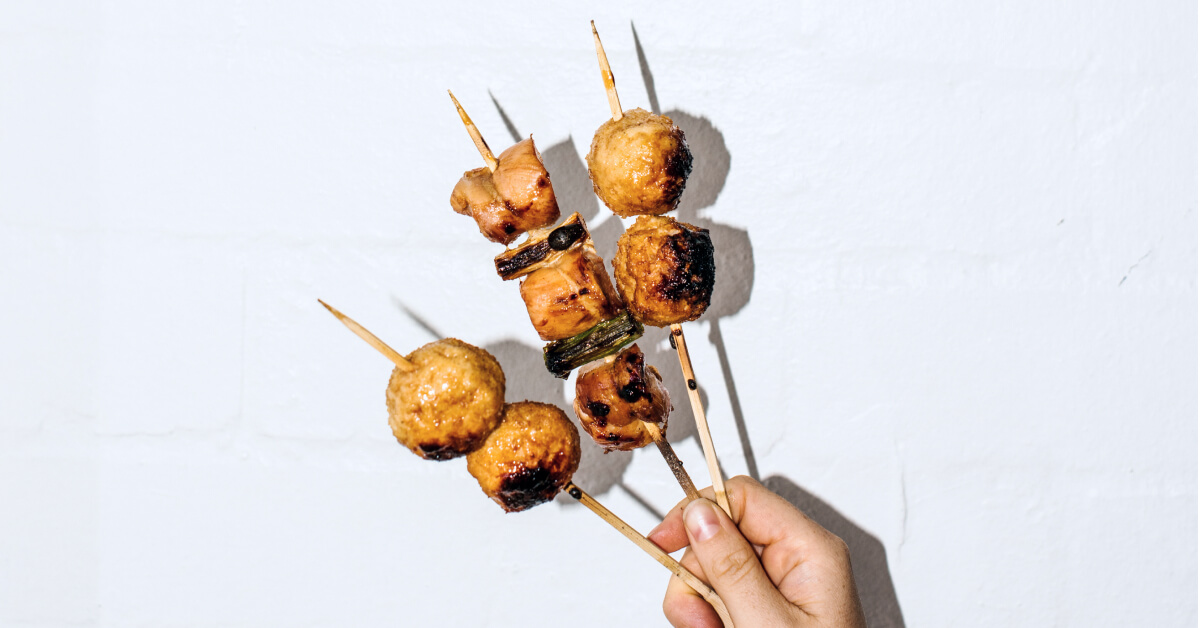"A Day in Tokyo" recipe + pairing | Yakitori

Yakitori! What’s not to love? If you’ve ever been to Tokyo you’ll know that unmistakable smell of charcoal-flecked skewer (and sampled 10 or 15 too, we’re sure). And if you’ve not been, allow this recipe from the excellent A Day in Tokyo by Brendan Liew and Caryn Ng (available now) to transport you. Plus - our tips for pairing, and a couple of recommendations, naturally.
Pairing tip: "Yakitori is a dish that straddles both a la carte and street-food settings, and a wine that plays in both spaces will fit the bill. The ripe, full fruit profiles of sauvignon blanc or pinot gris (or syrah if you’re a red-wine-only tragic) will compliment the relative simplicity of this cultural classic." - Pete, Wine Buyer
Holdaway Estate Sauvignon Blanc 2023
Refreshing and elegant, exhibiting bright acidity, nice fruit weight and subtle minerality. You find citrus in the form of grapefruit and mandarin, along with passionfruit, nettles and bell pepper. A nice little number out of Marlborough with a bit more going on than the usual savvy b. The Holdaway family has tended to its land in Marlborough since 1864, focussing in modern times on sustainability and biodiversity. This vintage, like every vintage before it, is classic sauv blanc; perfect with a skewer or four from the grill.
Patrick Lesec Apollon & Dionysos Syrah 2019
Made from syrah grown on pure clay which brings concentration, and grenache from sandy soils bringing finesse – a full-bodied and generous wine. Appolon & Dionysos as two opposite yet complementary forces governing art, according to Nietzche, the inspiration for the new Lumieres series by Patrick Lesec. In classic Lesec style, this is a powerful, classy and delicious wine. The power in this wine comes from the fruit, not oak, with only 10% of the wine spending time in barrel and the remainder raised in concrete. Approachable and pure yum, just like yakitori.

YAKITORI
Yakitori is a pretty recent dish in Japan’s culinary history, soaring in popularity only after World War II. This was partly because chicken was considered a luxury in ancient Japan, with the earliest yakitori stalls of the Edo period (1603–1868) serving the off-cuts (usually offal and gristle) from high-end chicken restaurants.
Today, salarymen crowd around the smoky counters of yatai (street carts) and yakitori-ya (yakitori shops), beer in hand, calling out their orders. There are also more upscale yakitori establishments that showcase chicken breeds from different prefectures, cooked over special binchotan (charcoal), with different cuts prepared using different methods. You might find chicken sashimi and a clear, rich chicken broth on the menu, and toppings on the counter such as wasabi, Yuzukoshō , Shichimi tōgarashi and sanshō (Japanese pepper).
It is hard to beat the irresistible scent and flavour of yakitori grilled over binchotan, but if you don’t have a charcoal grill at home, you can use a regular grill (broiler) or pan-fry the chicken. The two recipes here feature the chicken glazed in a glorious soy-based sauce (tare), but in Japan, you have the option of having it ‘shio’ –simply sprinkled with salt. The tsukune (chicken meatballs) are usually eaten dipped in raw egg, but using Hot-spring eggs is just as delicious.
Makes approximately 20 skewers
Yakitori tare
150 ml (5 fl oz) soy sauce 150 ml (5 fl oz) mirin
50 ml (1¾ fl oz) sake
100 g (3½ oz) raw sugar
2 spring onion (scallion) tops
Negima (spring onion and chicken thigh)
500 g (1 lb 2 oz) skinless, boneless chicken thighs
2 bunches spring onions, white and light green parts only, cut into 2.5 cm (1 in) lengths
Tsukune (chicken meatballs)
½ onion, finely chopped
500 g (1 lb 2 oz) minced (ground) chicken (see note)
50 g (1¾ oz) chicken cartilage, finely chopped (optional)
1 egg white
50 g (1¾ oz) silken tofu
1 tablespoon salt
1 teaspoon freshly ground
black pepper
1 tablespoon cornflour (corn starch)
panko breadcrumbs, for thickening (optional)
1 First, make the yakitori tare. Place all of the ingredients, except the spring onion tops, in a saucepan over medium heat and cook until reduced by one-quarter. Add the spring onion tops and simmer for another 10 minutes, then strain into a bowl. The tare can be cooled and stored in an airtight container in the fridge for up to 1 month.
2 If using bamboo skewers, soak them in water so they do not burn during cooking.
3 To make the negima, cut each thigh into four pieces and thread onto skewers, alternating between the meat and the spring onion. Season with salt and cover and place in the fridge until you are ready to cook.
4 To make the tsukune, soak the chopped onion in water for 15 minutes. Meanwhile, mix the chicken mince and cartilage (if using) with the egg white, tofu, salt and pepper, until everything is well incorporated. Drain the onion and pat dry with paper towel, combine with the cornflour, then add to the chicken mixture. If the mixture is too soft to work with, add 1 tablespoon of panko and incorporate, repeating the process if necessary until the mixture is firm enough to be shaped.
5 Shape the mixture into balls about the size of ping-pong balls, and thread two onto each skewer. Cover and place in the fridge until you are ready to cook.
6 Grill the skewers over charcoal. Just before the negima are completely cooked through, brush with the tare and continue cooking until done. If you are unsure whether or not they are fully cooked, you can cut the centre piece with a knife to see if the inside is opaque and cooked.
7 Dip both the tsukune and the negima in the tare and serve.
8 Alternatively, if you do not have a charcoal grill, pan-fry the negima and brush with tare as above.
9 Bake the tsukune in a 180°C (350°F) oven for 8 minutes, then pan-fry until browned on the outside. Dip both the tsukune and the negima in the tare and serve.
Note: For richer, gamier tsukune, substitute the chicken mince for duck mince.
This recipe is from A Day in Tokyo by Brendan Liew and Caryn Ng, published by Smith Street Books, $39.99, available now.
Photography © Alana Dimou